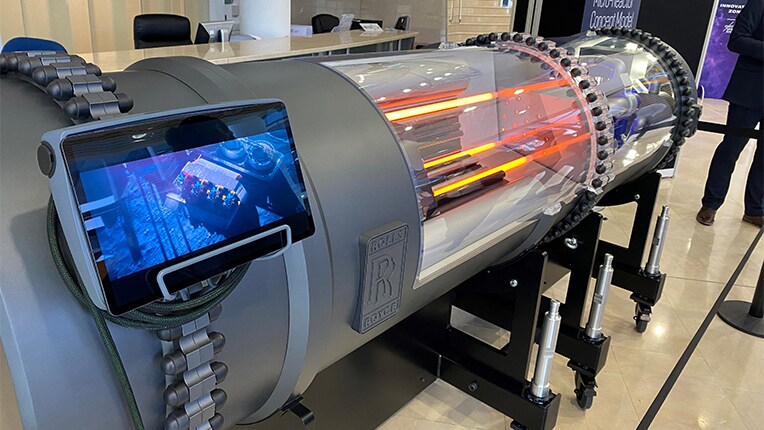Nuclear power on the moon: Rolls-Royce unveils reactor mockup
The company hopes to have a demo device ready for a moon trip in 2029.

The U.K. tech giant Rolls-Royce has unveiled a concept nuclear reactor that could power a future outpost on the moon.
The mini reactor, which appears to be about 3.3 feet (1 meter) wide and 10 feet (3 m) long, is not yet capable of producing any electricity, and it will take about six years and a few million dollars to get it ready for its debut space trip, if all goes according to plan.
The U.K. Space Agency awarded Rolls-Royce £2.9 million ($3.7 million U.S. at current exchange rates) in March of this year to fund the development of the potentially groundbreaking moon tech, a mockup of which was unveiled at the U.K. Space Conference in Belfast last month.
"This funding has enabled crucial research and development of technologies that bring us closer to making the Micro-Reactor a reality," Abi Clayton, director of future programs at Rolls-Royce, said in a statement on Friday (Dec. 1). "Our Space Micro-Reactor Concept Model allows us to demonstrate how this technology will bring immense benefits for both space and Earth."
Related: NASA funds nuclear probes for icy moons, huge new space telescopes and other far-out tech ideas
The reactor will rely on nuclear fission, the same process that enables Earth-based nuclear power plants to generate electricity. Most moon missions, including the rovers launched recently by China and India, have used solar energy as a power source, but that strategy has obvious limitations, as the moon is plunged into darkness for two weeks every month. Russia's 1970s Lunokhod rovers also relied on solar power while NASA's Apollo missions used hydrogen fuel cells to power the pioneering human lunar landings.
A simpler, less potent source of nuclear power used in spaceflight are radioisotope thermoelectric generators (RTGs). Those nuclear batteries rely on the natural process of radioactive decay, in which a less stable nucleus changes into a more stable one over time, releasing energy in the process. RTGs last a long time but don't produce enough power to keep a crewed mission going. The process of nuclear fission, on the other hand, splits a large atomic nucleus into smaller fragments. The reaction produces much more energy than simple decay but requires an external source of energy to kick-start it.
Breaking space news, the latest updates on rocket launches, skywatching events and more!
The new moon reactor will have a modular design, Rolls-Royce said, and have many possible uses on Earth as well.
"Micro-Reactor technology will deliver the capability to support commercial and defense use cases alongside providing a solution to decarbonize industry and provide clean, safe and reliable energy," Clayton said in the statement.
Rolls-Royce engineers are currently investigating methods that will enable the heat generated by the reactor through nuclear fission to be converted into electricity. In conventional nuclear reactors on Earth, this heat boils water, which then turns into a pressurized steam that turns a turbine. Such a system, however, might be a little too complex for a space-fit piece of tech.
"This innovative research by Rolls-Royce could lay the groundwork for powering continuous human presence on the moon, while enhancing the wider U.K. space sector, creating jobs and generating further investment," Paul Bate, chief executive of the U.K. Space Agency, said in the same statement.

Tereza is a London-based science and technology journalist, aspiring fiction writer and amateur gymnast. Originally from Prague, the Czech Republic, she spent the first seven years of her career working as a reporter, script-writer and presenter for various TV programmes of the Czech Public Service Television. She later took a career break to pursue further education and added a Master's in Science from the International Space University, France, to her Bachelor's in Journalism and Master's in Cultural Anthropology from Prague's Charles University. She worked as a reporter at the Engineering and Technology magazine, freelanced for a range of publications including Live Science, Space.com, Professional Engineering, Via Satellite and Space News and served as a maternity cover science editor at the European Space Agency.
